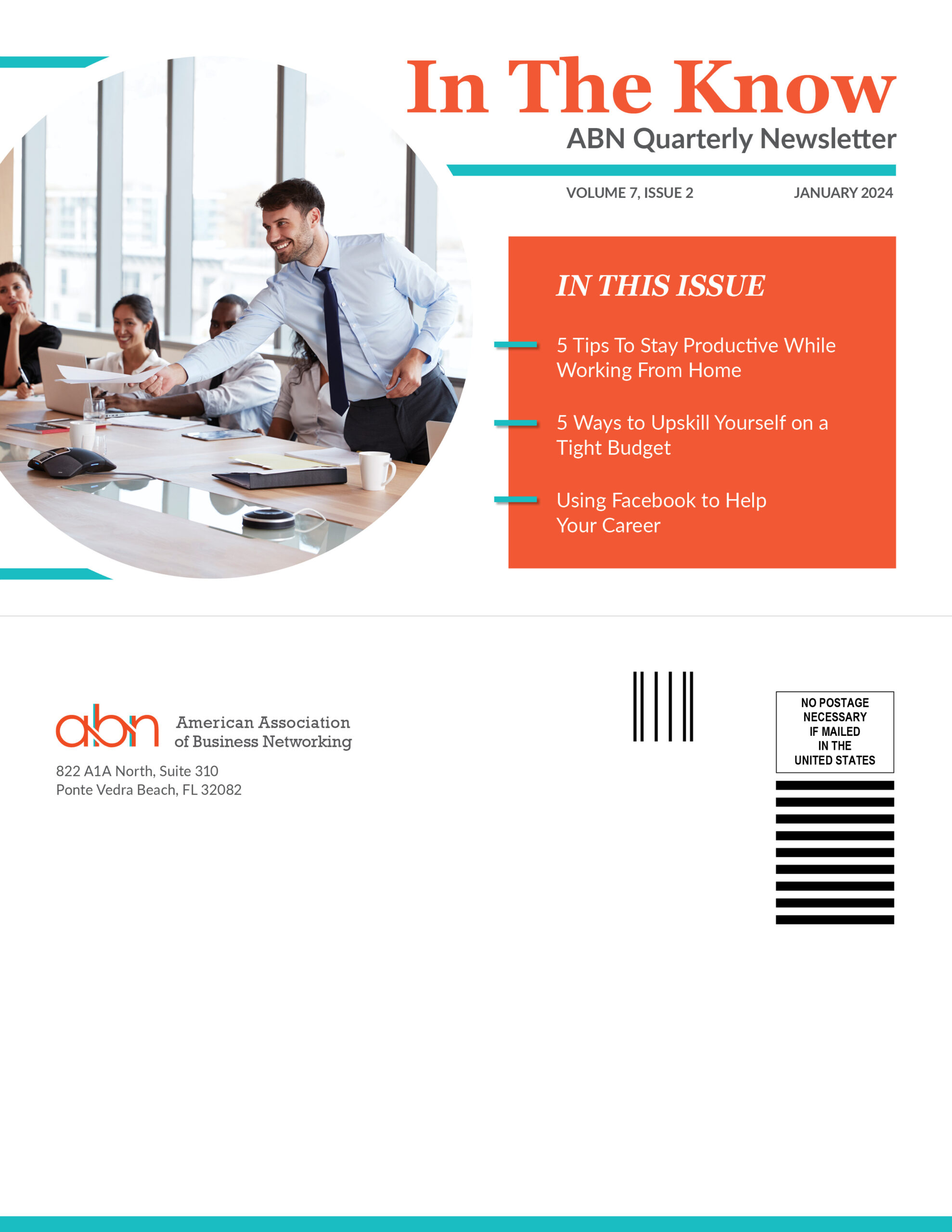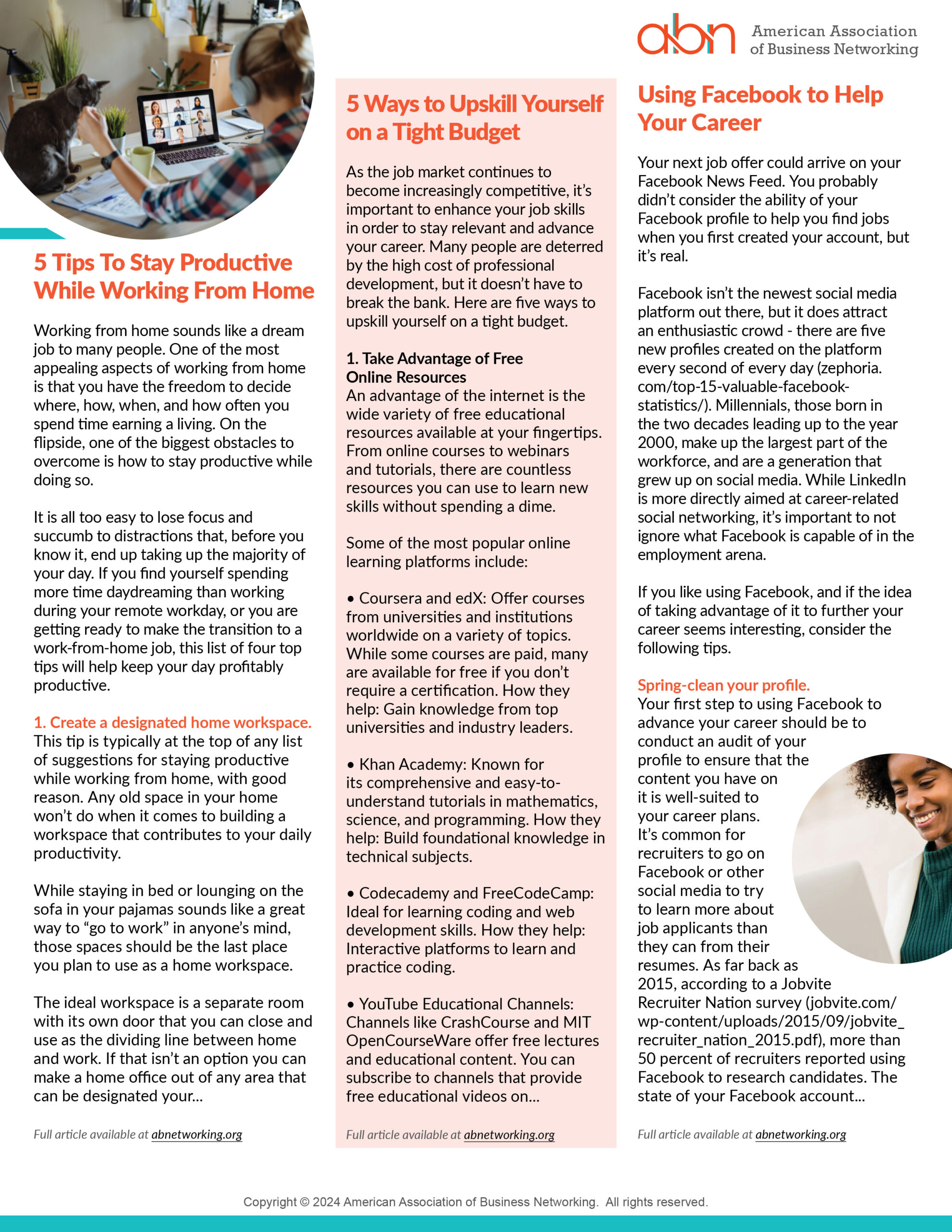ABN Newsletter Volume 7, Issue 2 January 2024



Working from home sounds like a dream job to many people. One of the most appealing aspects of working from home is that you have the freedom to decide where, how, when, and how often you spend time earning a living. On the flipside, one of the biggest obstacles to overcome is how to stay productive while doing so.
It is all too easy to lose focus and succumb to distractions that, before you know it, end up taking up the majority of your day. If you find yourself spending more time daydreaming than working during your remote workday, or you are getting ready to make the transition to a work-from-home job, this list of four top tips will help keep your day profitably productive.
This tip is typically at the top of any list of suggestions for staying productive while working from home, with good reason. Any old space in your home won’t do when it comes to building a workspace that contributes to your daily productivity.
While staying in bed or lounging on the sofa in your pajamas sounds like a great way to “go to work” in anyone’s mind, those spaces should be the last place you plan to use as a home workspace.
The ideal workspace is a separate room with its own door that you can close and use as the dividing line between home and work. If that isn’t an option you can make a home office out of any area that can be designated your workspace, where you can set up and arrange the tools you need for work, and enforce a “do not disturb while working” policy for family, friends, children, and even your pets.
For those with the option, choosing to work whenever you can find the time is detrimental to any hopes you may have for a productive day. This is usually because you end up either not working at all or putting in much less time, energy, and effort toward achieving a full day’s work output.
Establishing a daily schedule for your work time and a routine to follow for each day significantly boosts productivity by providing structure and organization for your work-from-home habits. When you know you must “go to work” at a certain time and in a specific way, it is easier for you to prepare yourself mentally for the day ahead and stay on track for achieving work output goals.
Whether you are working at home for someone else or for yourself, you should have goals you need to achieve each day and tasks to complete to achieve those goals.
It often helps to put these things in writing to give you a black-and-white point of reference to refer to when you want to gauge your progress or get yourself back on track. You can also track your productivity in writing, as well. A simple time-tracking spreadsheet is an excellent way to record what you are actually getting done each day and how much time is being spent on each activity.
At the end of the day (or week), you can review your productivity tracking data and see if there are things you are doing to contribute to or take away from your overall success in staying productive. This kind of performance monitoring is also a good way to determine if there are goal-oriented tasks that are taking too much time or are not being allocated enough time, as well. This gives you a better idea of whether you need to allocate more or less time and effort, and in what ways, toward reaching the goals you set for yourself each day.
Workers who do their job at a company location do not have the luxury of snacking throughout their day, playing fetch with their dog, reading a book to their kids, surfing the internet, or watching a movie. Those are home-related activities and should be kept out of your work-from-home routine except during any break time you designate for yourself during each day.
Likewise, you should also never interrupt your at-home time with work activities. Avoid popping in your office and answering emails because you passed by or stopping to check in on projects before your designated work time. When you keep your work life separate from your home life as much as possible, it helps you stay focused on accomplishing your daily work goals and keeping your productivity level as high as possible.
Staying organized is a cornerstone of productivity when working from home. It serves as the glue that holds all the essential elements of remote work together, ensuring that you can maximize your efficiency and achieve your goals.
A well-organized workspace not only minimizes distractions but also helps create a conducive environment for focused work. But it’s not just about your physical workspace. Organization extends beyond your desk to your digital realm. Keeping digital files and documents neatly categorized and labeled helps you locate crucial information swiftly. Effective digital organization also means setting up an efficient email management system, using project management tools, and maintaining a clear calendar.
When your digital environment is structured, you can prioritize tasks effectively, avoid missed deadlines, and collaborate seamlessly with colleagues. Ultimately, staying organized while working from home allows you to minimize stress, maintain a sense of control over your workload, and devote more time and energy to productive, meaningful work.
These five tips will get you going in the right direction toward working from home and staying productive at the same time. You can also find many other great ideas to add to this list and make your home-bound work life the dream job you always hoped it would be.

As the job market continues to become increasingly competitive, it’s important to enhance your job skills in order to stay relevant and advance your career. Many people are deterred by the high cost of professional development, but it doesn’t have to break the bank. Here are five ways to upskill yourself on a tight budget.
An advantage of the internet is the wide variety of free educational resources available at your fingertips. From online courses to webinars and tutorials, there are countless resources you can use to learn new skills without spending a dime.
Some of the most popular online learning platforms include:
Utilizing the public library to enhance your job skills is a smart and cost-effective strategy. Here’s how you can make the most of this valuable resource:
Webinars and events have become indispensable tools for upskilling in today’s fast-paced professional landscape.
Webinars
One of the key advantages of webinars is their accessibility. Unlike traditional in-person seminars, webinars can be attended from anywhere in the world, eliminating geographical barriers. This means you have the ability to learn from experts and industry leaders that you may not have otherwise had access to. Webinars offer a fantastic opportunity to learn from the pros without having to leave your home
Many organizations and companies offer these webinars at a minimal cost–or even free. They may cover a variety of topics, from entrepreneurship and career development to digital literacy and social media basics. These can provide valuable insights and strategies to help you improve your skills and knowledge.
Events
Events may offer the same type of industry expert advice and upskilling capabilities as webinars. But beyond the educational aspect, events also offer networking opportunities. You’ll hear from and converse with successful business leaders and entrepreneurs, which can help you gain insights and advice that can help you take your career to the next level. Plus, the networking aspect of these events will help you make connections that could lead to future job opportunities.
Volunteering for skills-based projects can be a win-win situation for both you and the organization you’re volunteering for. You can gain valuable experience and develop new skills while also making a positive impact in your community. The benefits include:
Look for volunteer opportunities that align with your interests and skills. For example, if you’re interested in marketing, look for opportunities to help a local nonprofit with its social media or advertising campaigns.
Networking with other professionals in your field can be a powerful way to upskill yourself and stay up to date with the latest trends and best practices. A few ideas for networking:
Each of these methods can help you build a professional network, learn from others, and find opportunities for collaboration and growth, all while keeping expenses minimal.
Upskilling yourself on a tight budget is not only possible but can also be an enjoyable and fulfilling experience. By taking advantage of online and community resources, attending webinars and events, volunteering, and networking, you can inexpensively better your skillsets and set yourself up for professional success.

Your next job offer could arrive on your Facebook News Feed. You probably didn’t consider the ability of your Facebook profile to help you find jobs when you first created your account, but it’s real.
Facebook isn’t the newest social media platform out there, but it does attract an enthusiastic crowd – there are five new profiles created on the platform every second of every day (zephoria.com/top-15-valuable-facebook-statistics/). Millennials, those born in the two decades leading up to the year 2000, make up the largest part of the workforce, and are a generation that grew up on social media. While LinkedIn is more directly aimed at career-related social networking, it’s important to not ignore what Facebook is capable of in the employment arena.
If you like using Facebook, and if the idea of taking advantage of it to further your career seems interesting, consider the following tips.
Your first step to using Facebook to advance your career should be to conduct an audit of your profile to ensure that the content you have on it is well-suited to your career plans. It’s common for recruiters to go on Facebook or other social media to try to learn more about job applicants than they can from their resumes. As far back as 2015, according to a Jobvite Recruiter Nation survey (jobvite.com/wp-content/uploads/2015/09/jobvite_recruiter_nation_2015.pdf), more than 50 percent of recruiters reported using Facebook to research candidates. The state of your Facebook account matters a great deal to any plan to grow your career.
If your Facebook account has embarrassing old college photos or odd status updates from years ago, they won’t likely endear you to recruiters. You need to set aside time to work through your profile post by post to hide or delete anything that would appear out of place in a professional setting. You don’t need to take out everything that expresses your fun, personal side; it would just be a good idea to take aim at anything that you wouldn’t be comfortable having your grandparents see.
You can, additionally, make use of the privacy settings on your Facebook account to help ensure that content you’d like to keep private is only visible to friends.
People tend to avoid mixing personal social media with their professional lives. In reality, however, recruiters usually feel better about doing business with people that they like on a personal level. It’s important to stop seeing it as a risky venture to mix your personal Facebook space with your professional life.
Once you are done cleaning up your profile, you should be comfortable using Facebook to make connections with clients, or the professionals that you meet at the networking events that you attend. Subscribing on Facebook to receive the latest updates from professional contacts through text messages can be a good idea. While it can seem like excessive engagement, it can be a quick and effective way to establish relationships with select people who are important to your career. Staying updated through text messages can be far less effortful than making your way into the Facebook app and scrolling to find updates from important contacts.
Being a part of groups frequented by professionals in your niche is another way to stay tuned in to people who are important to your career.
Starting a group on Facebook can be a powerful way to reach out to other professionals who share your interest in a specific topic. In general, creating a group on Facebook is a better idea than creating a Facebook page. Facebook groups have a more robust presence on Facebook’s algorithms, compared to pages. When you create a Facebook group, you’re more likely to have Facebook’s algorithms push your content until it is seen by others.
To be meaningful to others, a group on Facebook needs to directly speak to the interests of the people on it. Thinking of topics that are likely to appeal to professionals in your industry niche is a good plan. You need to bring up interesting questions to draw industry professionals into a conversation, and do your homework so that you’re able to add value to the discussion — through posting relevant thoughts, or links. The more value you bring to a group, the more likely you are to build your professional reputation on Facebook.
In general, it makes sense to choose to post in the afternoons; this is the most common time for people to be on Facebook.
Many employers post information about open positions they have, in just the way that they post status updates. When you’re in the market for a new direction in your career, it can help to look at the Facebook pages of the employers that you most admire. Facebook is home to about 80 million businesses, and they often post information about career openings. If a position opens up with an employer you like, you can apply directly on their Facebook page. Unlike some job posting platforms, applying on Facebook is free.
It may seem like you need to make a huge commitment to Facebook to make use of it for your career, but it doesn’t actually take much time. All you need to do is to set aside a couple of hours each week to look at your group, make meaningful posts, reach out to important contacts, and look for jobs. You’ll network effectively this way, and lay a meaningful foundation for the future of your career.

You’ve got a business, and you want it to stand out. A tagline can help you do that. A clever and engaging tagline will help your customers recognize, remember and relate to your business. It will also help distinguish your company from your competitor and convey the message that your company has something unique or special to offer.
A good tagline should be a sentence or short phrase that sums up what your business does and what makes it different from the competition. It’s a one-liner you can use to over open conversations and networking connections. Plus, it’s an important tool for advertising and marketing. The best taglines are memorable but don’t have to be cute or clever. It should be easy to remember and make customers feel something.
Here are some tips for designing your brand’s tagline.
When you decide on a tagline, do some research on what other brands in your industry say about themselves. How do they talk about their products? What words do they use? Are there any common themes among them?
You can also look at how larger companies — like Apple, for example — construct their messaging. You might notice that Apple uses simple language and avoids jargon when describing new technology. This kind of clarity helps set them apart from other computer manufacturers who rely heavily on technical terms or unfamiliar vocabulary.
Get inspired by other companies but don’t copy. See how you can place a clever twist on their tagline approach and make it your own.
Keep it simple and focused on one benefit. Don’t try to be all things to all people, and don’t try to be clever. It’s not a contest, so don’t worry about being the funniest or most relevant. Instead, focus on what sets you apart from your competition. Trying to convey too many benefits in one tagline will only confuse people and weaken your message.
Some of the best taglines to be inspired by include:
Notice how short and memorable each is? If it takes them more than a few seconds for people to understand your tagline, or if they must read it several times to remember it, think of something new.
Focus groups offer an effective way to get an idea of what people think of your business before you spend money on branding. It’s a cheap method, too — just ask friends and family if they’ll be willing to answer a few questions about how they feel about your company. Write down every word they say that describes your business and see which ones are most common.
You might even set up focus groups for different audiences. Maybe ask friends for their opinion, but also set up interviews with people in your industry who could provide more insight into what makes them want to buy from you instead of someone else.
If a tagline is too trendy, it can become dated faster than you think. Take “Just do it,” for example. It’s an iconic phrase that has become synonymous with Nike’s brand identity. It’s a short and memorable tagline that should withstand the test of time.
That’s what you want. When you choose a tagline, you want it to be timeless — something catchy but classy that will appeal to your target market no matter what trends are hot now. Your clients should look back years from now and recognize your brand.
A timeless tagline will be relevant for your customers for years after its conception. For example, Apple has used the motto “Think Different” since 1997, and since then, it’s been used on everything from print ads to billboards. As long as Apple stays true to its message — that they’re different than other companies — the slogan will continue to work into the future.
Now that you have a tagline ready to go, it’s time to put it to work. Ensure you use your tagline in every aspect of your business, so people can see it everywhere and begin associating it with your brand. Use your tagline on social media posts, business cards, newsletters, and more. Put it to work for you.
A well-written tagline can be the difference between a mediocre business and a successful one. It can help you stand out from your competitors, attract new customers, and make a lasting impact on existing ones. Your tagline is the first thing people will see and hear when they encounter your brand. It’s crucial that it makes an impression, so take your time coming up with one.
Try some of these tips and see what works best for you and your business. Even if your tagline isn’t the most creative or catchy phrase in the world, it can be effective if it conveys what you do in a memorable way.

Mentoring is a proven way to improve your skills at work. What’s more, having a mentor can increase your chances of getting a promotion or a pay raise. Some companies actively run mentoring programs; some encourage mentoring but don’t require it; many will leave it up to the employee to make their own arrangements. Whether your company expects you to have a mentor or it’s something you’ve decided to do for yourself, finding the right person can be a challenge.
Sheryl Sandberg, COO of Facebook, has described situations where she’s been approached by people she doesn’t know and asked to mentor them. A good mentor relationship likely won’t work if you’re just abruptly asking strangers at a conference. You might have admired them for years, but if they don’t know you, there’s no way that they can sincerely agree to mentor you.
In some companies with a flattened hierarchy, the relationship between you and your boss might be closer to mentoring than to oversight and management. That can be a positive thing, but the fact that your boss can be like a mentor doesn’t mean that he or she is the right person to ask. It’s much better to ask someone who knows you and understands your work situation but isn’t the person you’re directly responsible to.
Remember, you’re not going to ask someone who doesn’t know you, and you’re going to find someone who understands your situation but doesn’t directly manage you. Of course, there are online networks such as LinkedIn, but they tend to suffer from too much noise and not enough genuine connections. Events and professional conferences are great places to form relationships, but don’t go with the sole purpose of finding a mentor. (That would be like going to a friend’s birthday party just to find a date.) Instead, build up a range of relationships with people. Find someone who can answer your questions but who will also listen to your suggestions. When you can have conversations with someone that both challenge and affirm you, keep building that relationship.
Mentoring without a career plan is like trying to use your car’s navigational system without putting in a destination. Mentoring might help you reevaluate your plans — it can certainly help to increase your self-confidence and ambition — but it won’t provide you with a direction if you have no idea where you’re headed. Identify your areas for development. Which skills do you lack? What kind of situations do you avoid? Who do you find it hard to work with? Try to find a mentor who will challenge your deficits as well as build up your strengths.
Having a mentor at work can open doors to better job prospects and a more fulfilling career. A mentor needs to be someone who knows you well enough to see your potential and understands your situation so they can appreciate your problems. Identify your strengths and weaknesses and use networking opportunities to create a range of different relationships. When you develop a relationship that challenges you and builds you up, then consider asking about mentoring.

Charismatic leadership creates a strong emotional connection between leader and followers, resulting in a powerful force that can drive success in both individuals and organizations alike. This connection is often based on the leader’s personality traits, such as confidence, charm, optimism, and the ability to connect, inspire, motivate, and engage others. Charismatic leaders create a sense of purpose and direction that can help their followers achieve greatness.
Let’s take a closer look at the traits associated with this style of leadership, and how it can drive success in various settings.
One of the most important traits associated with charismatic leadership is confidence. Charismatic leaders are often highly self-assured individuals who are comfortable in their own skin, they believe in themselves and their abilities, and they are not afraid to take risks or make bold decisions. Their expressivity and confidence are contagious and inspire others to believe in themselves and their own potential.
An example: Oprah Winfrey, widely recognized as one of the most successful and influential media personalities of all time, has built a multi-billion-dollar empire through her business ventures. Throughout her career, Oprah has displayed unwavering confidence in herself and her abilities, often taking bold risks and making difficult decisions with conviction. She has always been unafraid to speak her mind, and her confident demeanor has helped inspire millions worldwide to pursue their dreams and achieve success on their own terms. Despite numerous challenges and setbacks throughout her life, Oprah has remained steadfast in her belief in herself, and her unwavering confidence has been a driving force behind her success.
Another common trait is optimism. Charismatic leaders see the bright side of things, even in the face of adversity. Faced with challenges, they find the silver lining, no matter how tough the situation is. Their positive attitude is infectious, and their upbeat countenance elevates others. This is particularly vital during rough times when it’s easy to feel disheartened or overwhelmed. Charismatic leaders provide a beacon of hope, helping everyone focus on the bigger picture.
Charismatic leaders have a certain charm that sets them apart from the rest. They have a natural ability to connect with people and make them feel comfortable. Maybe it’s their infectious smile or their witty humor that draws people in, but there’s no denying the charm they possess.
This charm is an asset in building strong relationships with team members. Charismatic leaders can create a sense of camaraderie and foster collaboration within their teams. They have a way of making everyone feel valued and appreciated, which leads to a more positive work environment. When team members feel comfortable around their leader, they’re more likely to share their ideas and contribute to the team’s success.
One of the key benefits of having a charismatic leader is the ability to build a strong network of supporters. When a leader inspires people, they become invested in the movement and reach out to others who may be interested. This can help build a sense of community and shared purpose, which can be crucial when it comes to taking action to achieve change.
This can also be effective in politics and social movements. Leaders with charismatic qualities often rally large groups of people around a particular cause or vision. They are often skilled at communicating their message in a way that resonates with others, and they can generate public support for their cause. They inspire people to believe in their message and often generate significant momentum and enthusiasm for their cause. Additionally, charismatic leaders are often skilled at negotiating and building coalitions, which is important when it comes to enacting change.
Having a charismatic leader can have a significant impact on the success of an organization. Charismatic leaders possess a range of personality traits that make them stand out from the crowd, including confidence, optimism, and an ability to inspire others. They’re also highly skilled at networking and building relationships, which can be invaluable for securing new business opportunities or forging partnerships with other organizations. These leaders can create a vision that resonates with followers and empowers them to achieve extraordinary results.
While not everyone is born with charisma, the trait can be developed over time through practice and self-reflection. By fostering a culture of charismatic leadership, organizations can drive success and achieve their goals.

Though most entrepreneurs start out alone, new businesses increasingly start as partnerships. Good partners share the workload, the risk, have complementary skills, and provide second opinions. Your sources for business partners will depend significantly on your previous experience. You may have to explore far outside your bubble, but if the business idea is good, then the right business partner is out there.
If you’re starting a business in a field where you have little experience, you’re probably going to have to do a lot of networking to find a business partner. You’ll be approaching people with more experience, so make sure you have good new ideas and a solid business plan to bring to the table. Having strong confidence in these ideas will help you get through.
Start making contacts at trade shows, local business association meetings, and professional associations, depending on the type of field you’re looking to enter. Make sure you can concisely break down what your business is, and don’t be shy about asking people for connections.
Consider also looking at volunteer and non-profit work to build up your resume and network. A wide range of energetic, confident people work at these organizations who might know important people or have the makings of good potential partners themselves. Coming into contact with a broad cross-section of people will also help you work out kinks in your business plans. Pitch your ideas to willing listeners, and take constructive criticism.
If you’ve had good relationships with bosses and other experienced business leaders in the past, consider them as potential partners and ask them for advice. It might seem awkward working with a former boss in an equal partnership, but the additional experience they bring is often invaluable.
If former mentors suggest a partner, be sure to get to know them well before jumping in. Just because someone you trust recommended them, it does not necessarily mean they are the right fit. Maybe they worked well with someone you trust, but it does not mean they’ll work well with you.
Consider former coworkers as well. Their abilities should be easier to judge, and you’ll already know if you work well together, whether they share your vision, and whether you can trust them. However, avoid coworkers that are too similar in skills and experience. Consider people you know well, but who worked in separate teams or departments. For instance, someone from marketing might partner well with a coworker from design.
Entrepreneurs tend to be big on vision, but uninterested in the nitty-gritty details of running a business. A more technically minded person, such as an accountant or an engineer, could help keep you down to earth when you get lost in the cloudy possibilities of tomorrow.
On the other hand, if you’re a tinkerer with a great idea, a good managerial type could help you get out of your box. They can take care of the long-term planning to bring your detailed idea forward into a more generalized environment.
Many people avoid choosing friends and family as business partners, and often for a good reason. But just because it can be a bad idea does not mean it always is. More than any of the other suggestions given, you probably know your friends and family well, which means you probably know whether you can get along with them and whether you can trust them. Now, this does not necessarily mean picking your best friend or favorite sibling as your business partner; they must share your vision but offer their own set of skills.
Take advantage of all your contacts and search widely for a business partner, but don’t forget people closer to home. Someone is out there who shares your vision, can take the work, and offers complementary skills. It might take a little time and networking, but a good partner can take a business to places an individual entrepreneur can’t make it alone.